Public houses, inns, beer houses and breweries of Wokingham – 1901
Chris French, May 2020
A History
On this page are the main locations in Wokingham known in 1901 to be concerned with the consumption of beer – alehouses, taverns, public houses and hotels. Where it has been possible to obtain information and photographs of the building in 1901 these have been given: where the building still exists today, a description and photograph of it in 2011 are also given, as a comparison.
You can test your knowledge of the subject by trying our Pub Quiz or join us in a historically-themed virtual pub crawl round Wokingham's pubs, past and present.
Background
A group from Oxford University produced a document entitled 'An Account of Early Victorian Wokingham – Town and Parish' in 1984, based on data from the 1851 Census. The Wokingham U3A Local History Group decided to produce a follow-up document (Late Victorian Wokingham), based on the 1901 Census, following fairly closely the format of the original document and covering the situation 50 years on. I chose to take on the chapter entitled 'Inns, Alehouses and the Drink Trade'.
In the original document, this topic took only two pages. As a result of my particular interest in photography, I decided as a parallel activity to expand the topic and produce this document – gathering what I could in the way of photographic data from around 1900, and supplementing this with a comparative photograph of the building (or location) as it is today.
Introduction
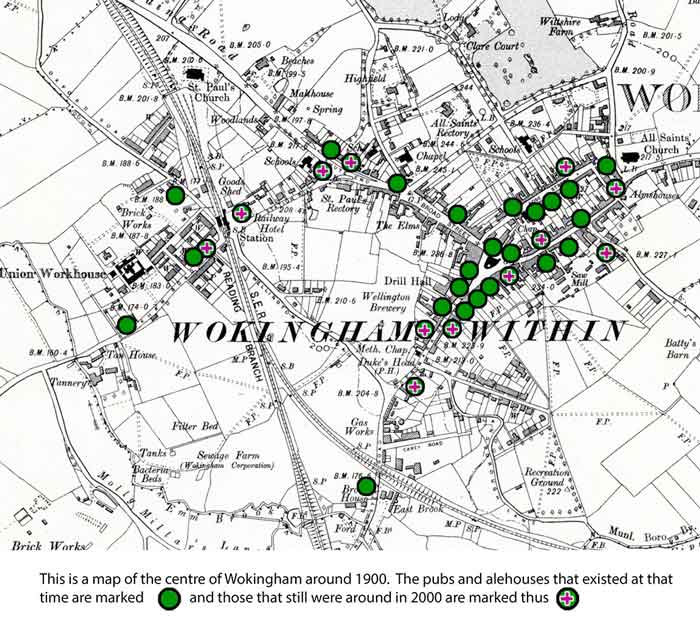
In 1830 a series of events began which were to change drastically the production and consumption of beer in Wokingham. Some events, like the Beer Act and the coming of the railway, were of national importance; others, such as the enforced sale of Haywardʼs brewing empire were of more local significance.
The first of these events, the passing of the Beer Act in 1830, was an attempt by the government to wean the working classes away from gin drinking. It removed the duties on beer and cider so that once again beer became cheaper than spirits. In addition it allowed any ratepayer who paid two guineas (£2 2s) to the local excise office to sell beer from his house without having to obtain a licence from the magistrates. At the time beer was viewed as harmless, nutritious and even healthy.
The total number of beer houses and public houses known to have opened in Wokingham between 1830 and 1900 is 33. It is likely that perhaps half as many again opened and closed after a few years, all record of them having since been lost. The end of the century brought the total of licensed premises to 41, but in all the 70 years since the passing of the Beer Act only two new houses had been opened with a full license, the Railway and the Rifle Volunteer, and the latter was a replacement for the Horse and Groom.
The Wine and Beer house Act 1869 reintroduced the stricter controls of the previous century.
The completion of the railway line from London to Reading in 1840 resulted in the total demise of the stage coach service from Bath and Bristol to London by 1843 and the loss of much trade by the inns along the Bath Road. A diminished service, however, continued between Reading and London via Wokingham with just one stage coach, S. William’s Windsor Park Coach calling at the Rose. The coming of the railway also had a considerable effect on Wokingham's licensed trade. The Railway was built next to the station by Hayward's Brewery. The opening of the South Western railway line to London in 1856 gave Wokingham a direct link to the capital. The Engineer (now the Two Poplars) initially relied on the construction workers for its custom. Overall, the railways brought more travellers to the town and a great impetus to the beer trade.
Public houses, inns, taverns and beer houses
Closures
Between 1850 and 1901, at least 21 public houses, inns, taverns or beer houses closed down. They are listed below in alphabetical order, with the date last mentioned.
| Name | Location | Last date |
|---|---|---|
| The Albion | Barkham Road | 1880 |
| The Alma Arms | Reading Road | 1857 |
| The Alma | Barkham Road | 1850 |
| The Bee Hive | Emmbrook | 1900 |
| The Brickfield Tavern | Spring Cottage Forest Road | 1854 |
| The Bricklayers Arms | Rose Street | 1871 |
| The British Workman | Market Place | 1881 |
| The Dog and Partridge | Nine Mile Road | 1871 |
| The Eagle | Peach Street | 1854 |
| The Good Intent | Peach Street | 1854 |
| The Horse and Groom | Reading | 1859 |
| The Kings Head | Market Place | 1852 |
| The Poor Man's Friend | Rose Street | 1851 |
| The Red Cow | Market Place | 1884 |
| The Robin Hood | Down Street ∗ | 1854 |
| The Sedan Chair | Down Street ∗ | 1877 |
| The Spotted Cow | Emmbrook | 1885 |
| The Spotted Cow | Heathlands Road Gardeners Green | 1872 |
| The Spread Eagle | Denmark Street | 1883 |
| The Weldale Arms | Peach Street | 1871 |
| The White Hart | Hones Green ∗∗ | 1854 |
∗ Down Street became Denmark Street after the Princess of Denmark (later Queen Alexandra) who married Edward, Prince of Wales, in 1863.
∗∗ Hones Green is the Honey Hill/Gardeners Green area.
A Virtual Pub Crawl
Chris French presents a virtual walk around Wokingham's pubs, past and present.
Wokingham's pubs in detail
The Anchor - 37 The Terrace
Up to 1901
The Anchor Inn opened in 1777. In 1901 it was just 6 doors away from the Queens Head.
1901 to 2011
The inn closed in 1910 and is now a private house.

The Brewery Tap – 13 Broad Street
Up to 1901
The Brewery Tap was next door to The Shades and probably interlinked: they were both used as a direct outlet for the Wokingham Brewery, behind these buildings.
The Bush Hotel - 37 Market Place
Up to 1901
The timber-framed 15th and 16th century buildings that make up much of present-day Bush Walk were previously part of the Bush Inn. After being a stagecoach inn for 100 years, by 1901 it had become a hotel.

1901 to 2011
The Bush Hotel closed in 1986 and has now transmuted into the Bush Walk shopping arcade. The pub-like sign is clear to see, although the design is very modern.
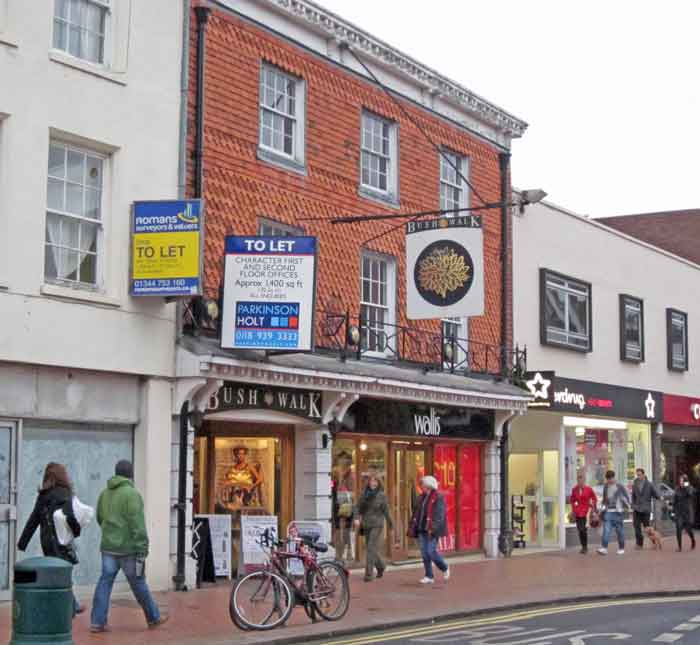
The Cricketers – 29 Rose Street
Up to 1901
The 15th century building in the foreground has had a variety of uses, including (from the start of the 20th century) that of a public house called The Cricketers. In this photo it had very recently been converted into a fish shop.
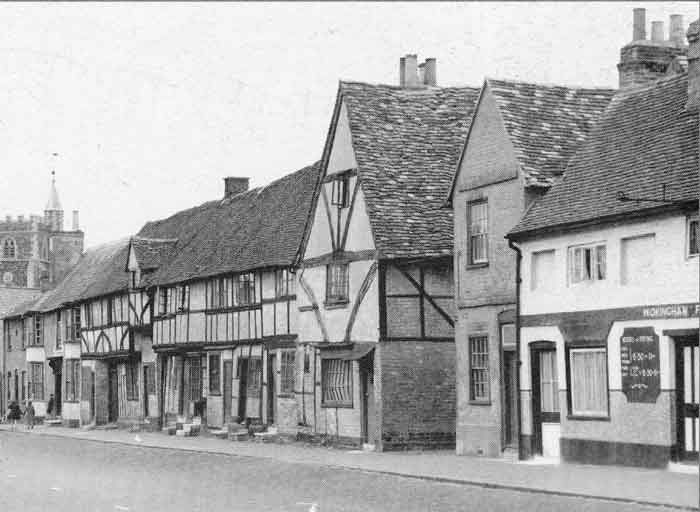
1901 to 2011
The chimneys and front elevation have not changed much since the previous photograph and the bracket for the pub sign remains intact.
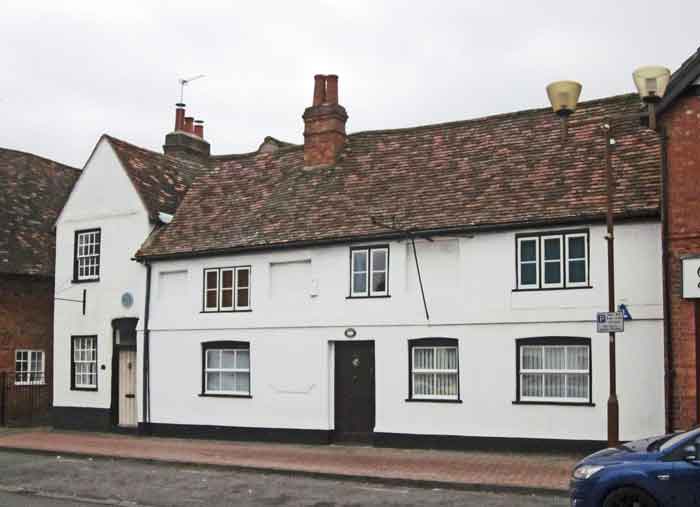
The Crispin – 45 Denmark Street
Up to 1901
The Crispin is one of the oldest buildings in Wokingham. It was built in the 15th century as a hall-house. This means it had a large central hall – the main room of the building – open to the roof, with a fire in the centre of the room. It was obviously the home of a prosperous man. In later times it was 'modernised', and an upper floor built across the full breadth of the house.
Some time later it was divided into three cottages. By 1854, the owner of the central cottage (James Green) had become sufficiently prosperous as a 'brewer and beer seller', to buy out the other two owners and use the whole building as an inn.
1901 to 2011
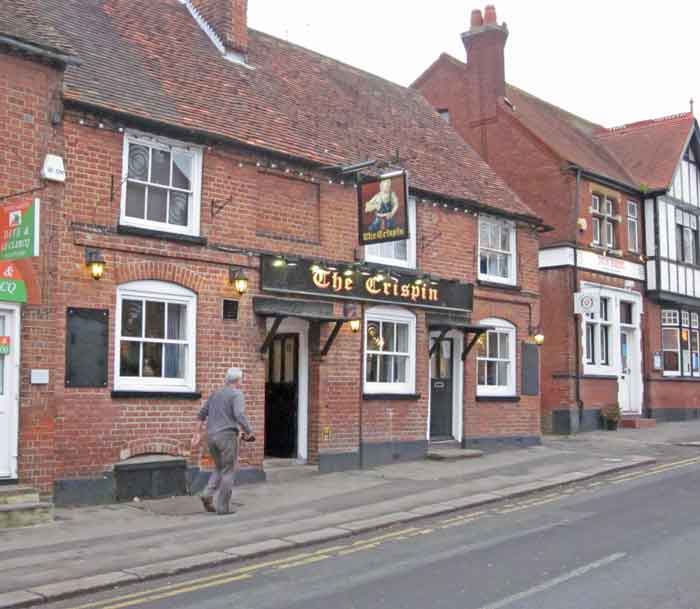
The Crooked Billet – Gardeners Green
Up to 1901
The pub name is capable of various interpretations, but the sign depicts a small twisted log of wood.
There was a story that the house once stood on the other side of the road and that it was moved to avoid being flooded by the nearby Emm Brook. Although it is possible that a timber-framed building could be moved, it is unlikely. It is more likely that the road was diverted to pass on the other side of the building. Whatever happened, if it did, was early in the 19th century and no sign of diversion has been found.
1901 to 2011
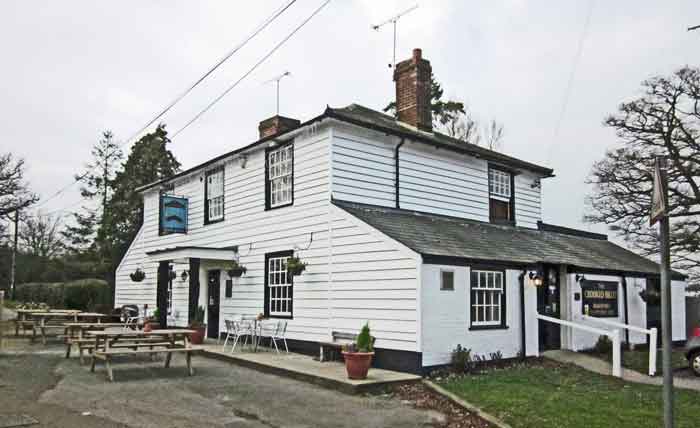
The Crown – 29 Peach Street
1901 to 2011
This parade of shops, including the ex-Woolworths store to the right, was redeveloped in the 1930s.

The Dog and Duck – Mathewsgreen Road, Emmbrook
Up to 1901
The Dog and Duck at Emmbrook started life as a beer house. Absolom Deane received the first licence in 1851 when he was 80 years old (and described in the census as a gardener). Brakspears Brewery bought it in 1857 and by 1901 it was an attractive public house in a rural setting.
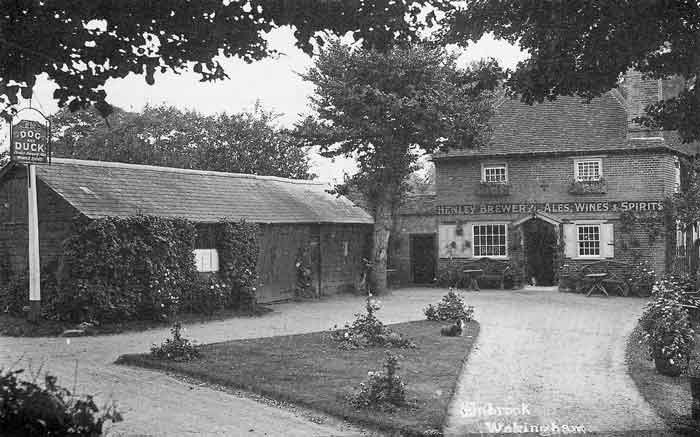
1901 to 2011
The sign now shows a black dog, thought to be an Irish water spaniel, gazing up at a duck in flight.
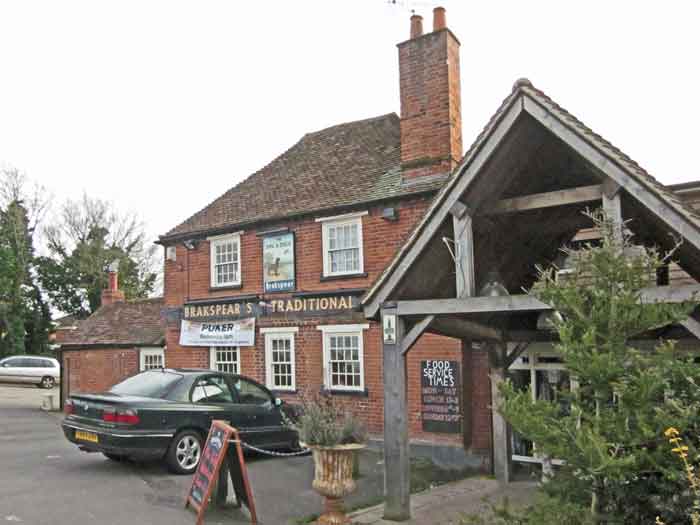
The Duke's Head – 1 Langborough Road
Up to 1901
Originally 3 cottages, the Duke's Head was first mentioned as a public house in 1795.
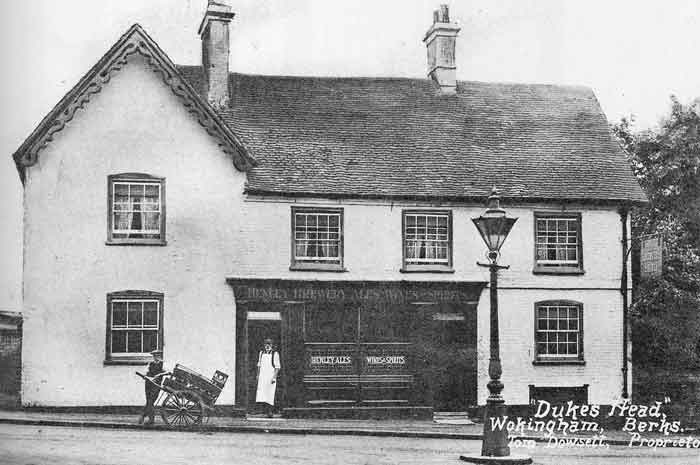
1901 to 2011
The two entrance doors of 1901 have been blocked up and a modern entrance made on the left of the building.
The yard of the present public house contains a 200-year old building, now restored for use as a skittle alley.
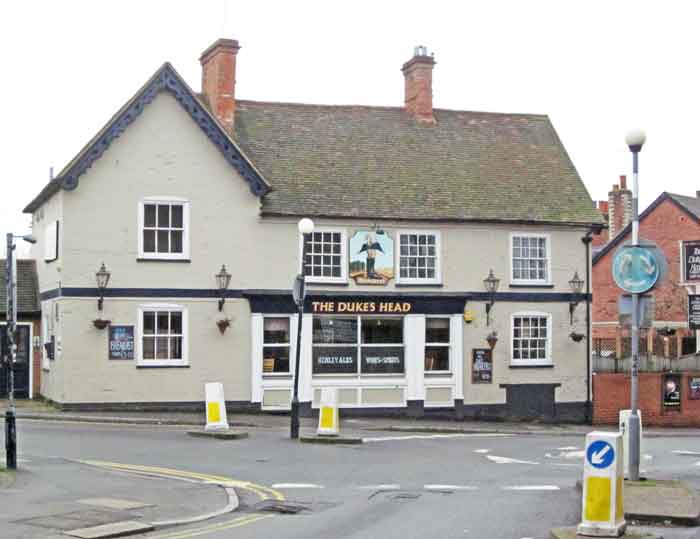
The Eagle – 9 Rose Street
Up to 1901
The Eagle was a retail outlet for the small Eagle brewery, on the same premises. It was later renamed The Bear.
1901 to 2011
All that remains of the site is now hidden behind the walls of the car park.
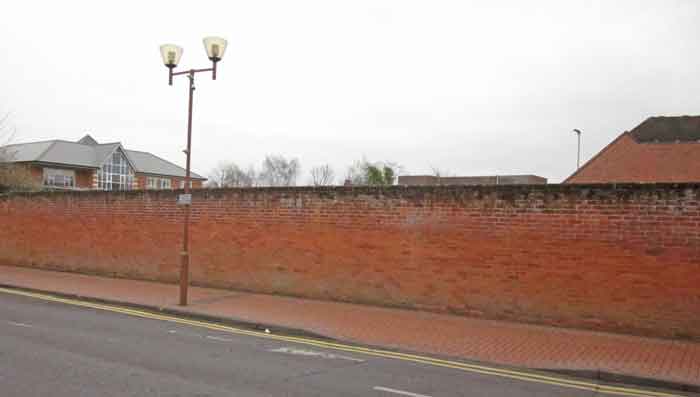
The Fox and Hounds – Forest Road
1901 to 2011
The Fox and Hounds, situated on Forest Road and quite close to the Warren House, is now a private cottage.
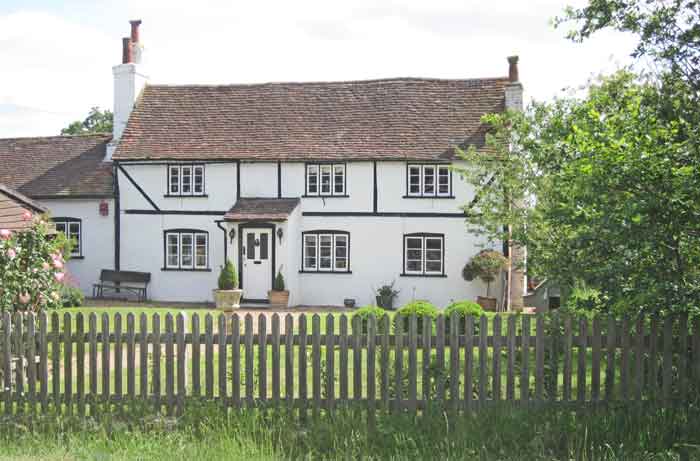
The Hope and Anchor – Station Road
Up to 1901
The right hand side of the Hope and Anchor still occupies this 15th century hall-house, while the other end of the bar was formerly a smithy, but this was not built until the second half of the 19th century, after the pub had been in existence for some years. The garage and entrance to the garden were also built about the same date. It was built in 1840 and in 1901, at the time of this photograph, it was owned by Baker, Powell and Co., the Wokingham Brewery that was based in Broad Street.
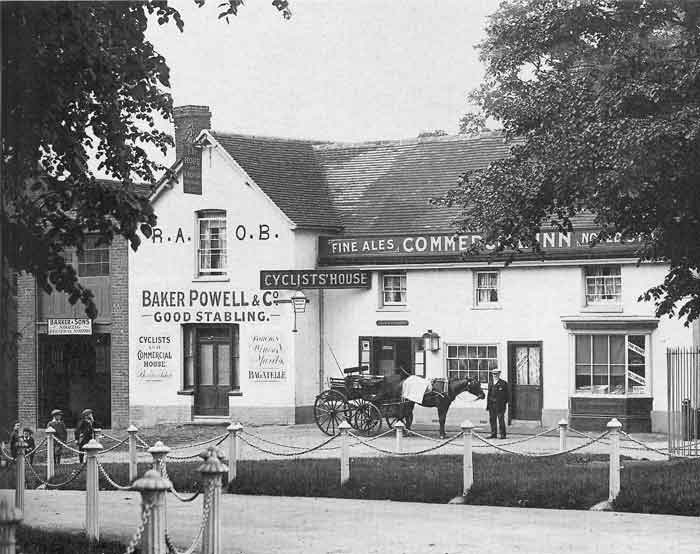
1901 to 2011
The Hope and Anchor as it is today at the top of Station Road opposite the Council offices.
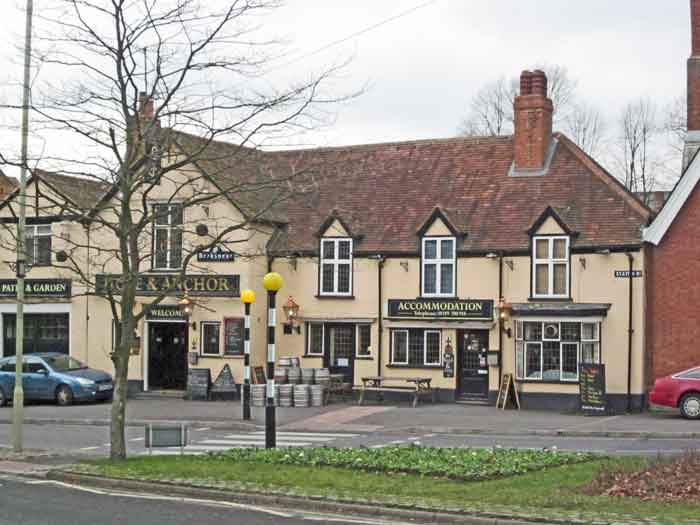
The Lord Raglan – 30 Denmark Street
Up to 1901
The building began as three cottages built in the early 19th century. Thomas Searle was the landlord from 1830, when it was a one-roomed alehouse, until his death in 1887, by which time it was an inn with five bedrooms.
1901 to 2011
Despite its humble beginning, the building is a listed one. However the inside of the house has been extensively altered and opened up so that today it bears little relationship to the original interior.
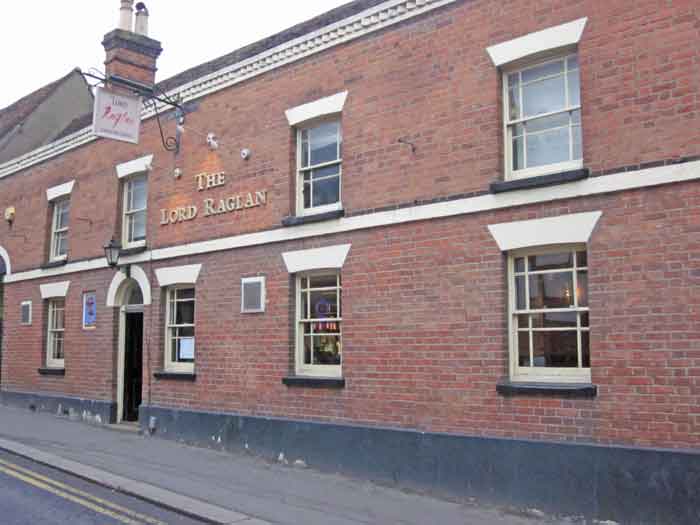
The Metropolitan – 58 Rose Street
Up to 1901
This photograph shows the landlord and some of his customers outside the Metropolitan beer shop in Rose Street. The owner is wearing the bowler hat and shirtsleeves. The building is a 15th century hall-house, modified over the centuries to meet the needs of its owners.
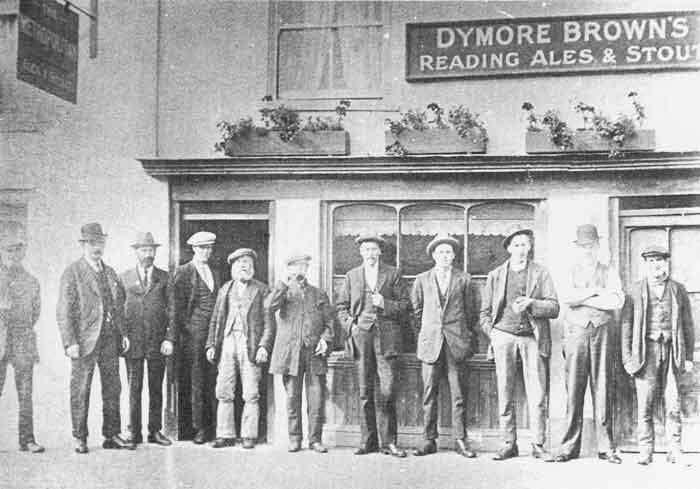
1901 to 2011
The sign shows a guardsman, standing against a London background. No satisfactory explanation has been put forward as to the origin of the name. Most probably it was the whim of an individual landlord.
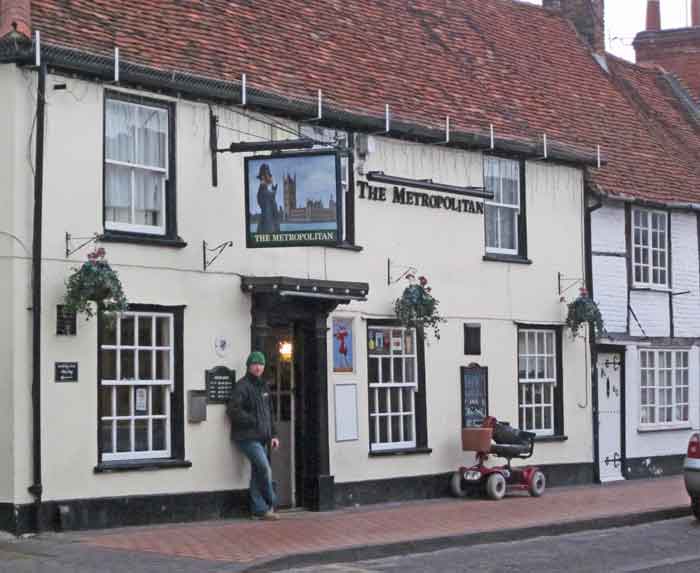
The New Leathern Bottle – Barkham Road
Up to 1901
The New Leather Bottle was a short-lived beer house (c.l870 — c.1911) at Sand Pits, on the Barkham Road, on the Walter estate; sometimes confused with a separate establishment, the Old Leathern Bottle (or 'Bottel' as it's now named) that was about 400 yards away.
The Pin & Bowl – Finchampstead Road
Up to 1901
Probably built in the 16th century, the establishment underwent many changes over the years – beer was being brewed here in 1722 and sold here in an alehouse here in 1740.
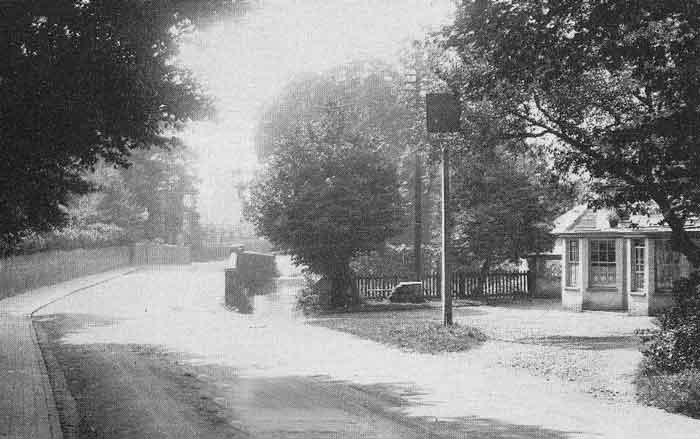
1901 to 2011
The Pin and Bowl closed in 1992 and was demolished shortly afterwards, in 1995, when this small shopping complex was built. At the time it closed it was probably the smallest public house in Wokingham. The latest Barnett's street map of Wokingham still includes the Pin and Bowl, showing its former position.
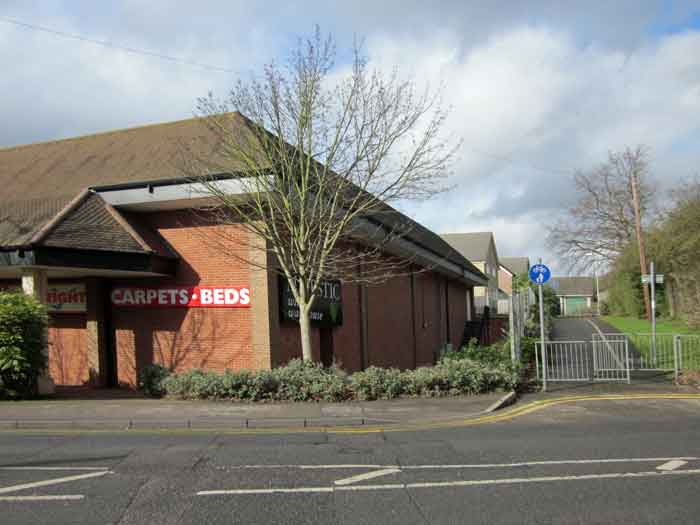
The Plough – London Road
Up to 1901
The earliest known licensee, in 1850, was Charles Johnson; within a year his wife had taken over the licence. Like so many other small pubs the income from it was too small to support a family and Charles had become a mailman. Two years later the Johnsons had gone and the licensee was Thomas Rance, the first of the Rance family who were to run the Plough until 1911. The family are thought to have given their name to the nearby Rances Lane. The original Plough was a beer shop, sited just round the corner from the present building – on Plough Lane, rather than fronting onto London Road.
1901 to 2011
The current building was built in 1924 and until 2006 the Plough continued as a public house, but has now been converted into a restaurant.
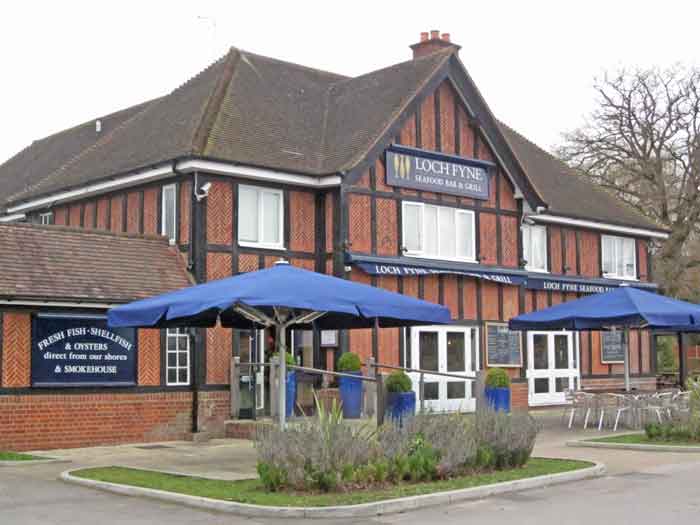
The Queens Arms – 23 Rose Street
1901 to 2011
The support for the inn sign can still be clearly seen.
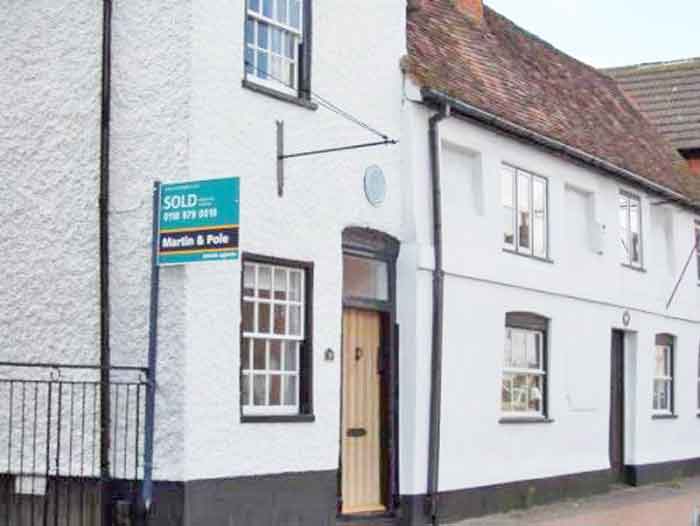
The Queens Head – 23 The Terrace
Up to 1901
Looking along the unmade surface of Shute End, past The Terrace, on which stands The Queen's Head.
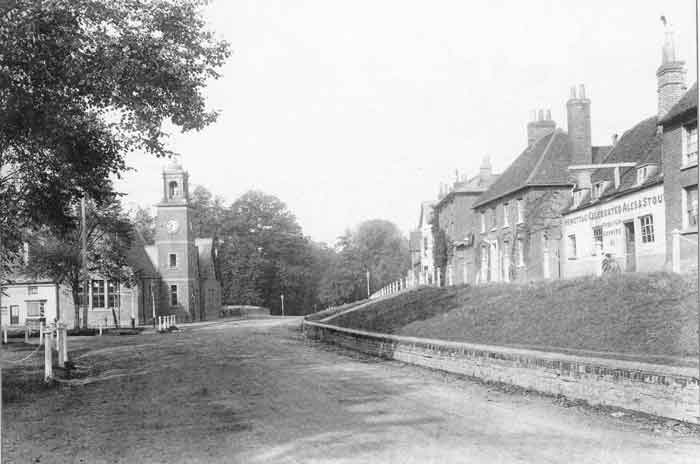
There is no mistaking the service offered by this establishment. The building, which dates from the 15th century, is notable as the only building in Wokingham known to have a cruck frame as part of its construction, a feature that is relatively common in Northern England, but less so in the South-East; only seven buildings with this form of construction are known in Berkshire.
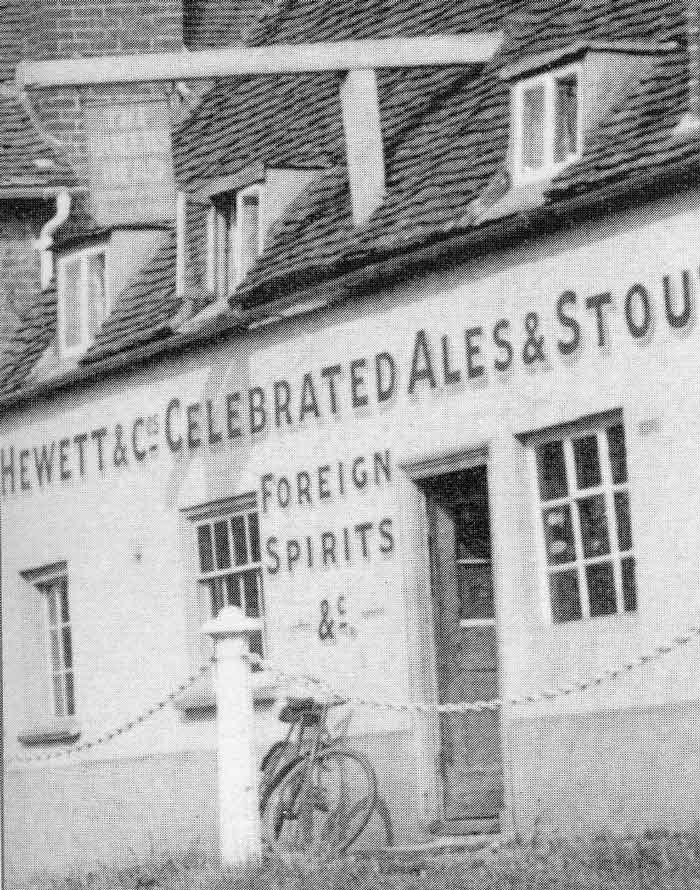
1901 to 2011
Much remains the same today, including the unusual support for the inn sign and the dormer windows.
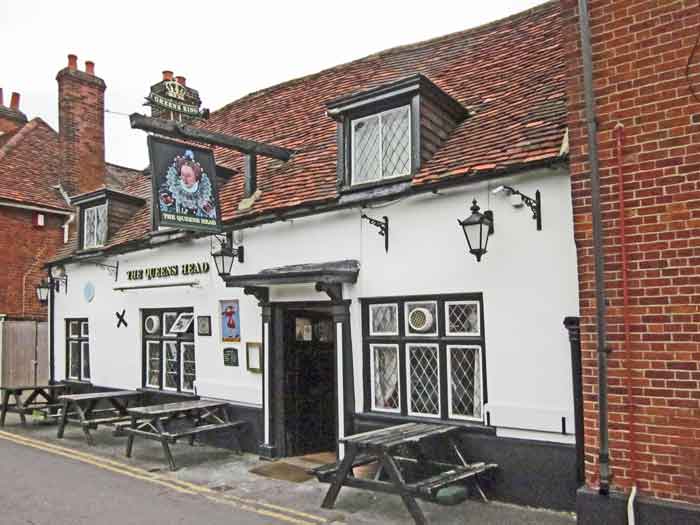
The Railway Hotel – Station Road
Up to 1901
This is Station Road, looking up the hill towards The Terrace from the railway crossing. The Railway (as it was initially named in 1849) became first the Railway Tavern and then the Railway Hotel, as its fortunes flourished. In 1856 it was bought by the Wokingham Brewery. By 1901 it had a larger trade than the Rose Hotel. An annex, the Railway Tap, was opened at the back for those customers who were not as wealthy as the main patrons of the hotel.
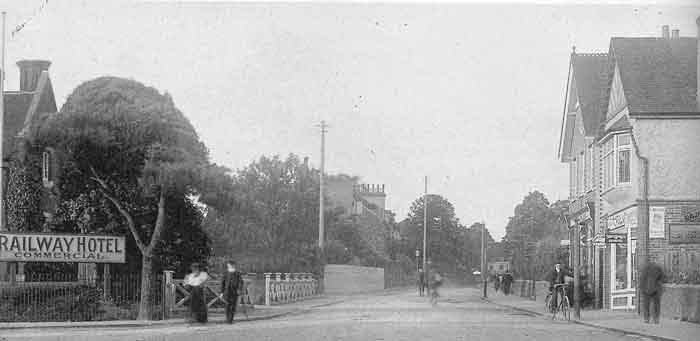
This view also shows the Railway Tap, on the left – well out of sight and earshot of the hotel guests.
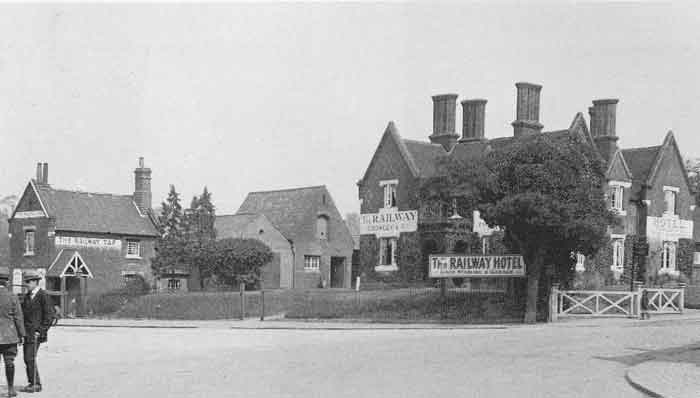
1901 to 2011
The prestigious Railway Hotel has now become the Molly Millar and has been 'demoted' to a pub.
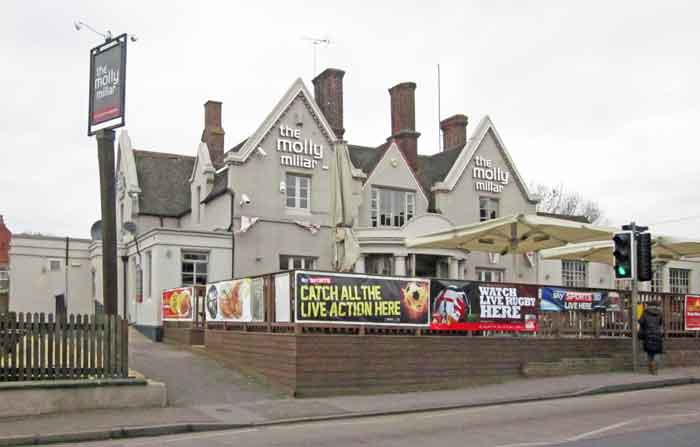
The Red Lion – 25 Market Place
Up to 1901
The Red Lion is one of the oldest buildings in Wokingham. However, seen from along Red Lion Path it is obvious that the pub is made up of a number of buildings of different ages.
1901 to 2011
The entrance to the stables at the rear can still be clearly seen.
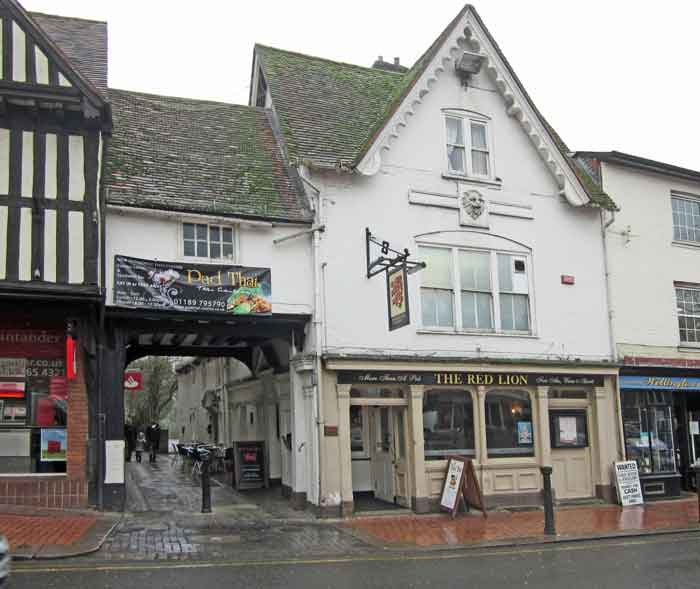
The Redan – 24 Peach Street
Up to 1901
This is one of the new buildings in this area of Wokingham, which later became the Redan, and it was originally built in 1842 as part of the development on the site of Hall's Academy, a former private school. The inn itself was rebuilt in 1869. Richard Arnold was the licensee in 1901, but in 1903 he lost his licence and was fined 40 shillings and costs at the Brewster Sessions for permitting drunkenness.
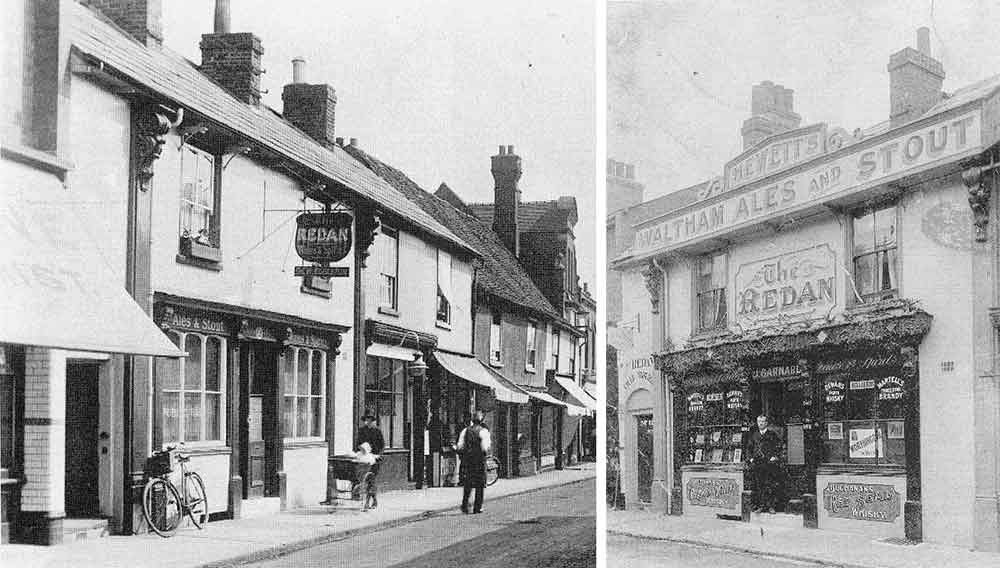
1901 to 2011
The Redan as it is today
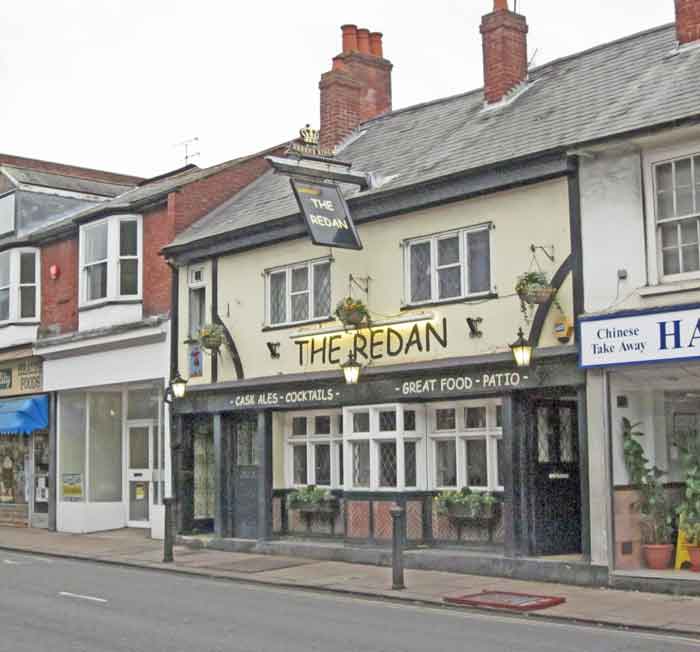
The Rifle Volunteer – 141 Reading Road
Up to 1901
The peace and quiet of this scene by the Rifle Volunteer on the Reading Road has vanished forever, leaving only the public house as a reminder of times past. Originally just 'The Volunteer', it replaced an earlier public house called The Horse and Groom. In 1901 it belonged to Nicholsons Brewery of Maidenhead.
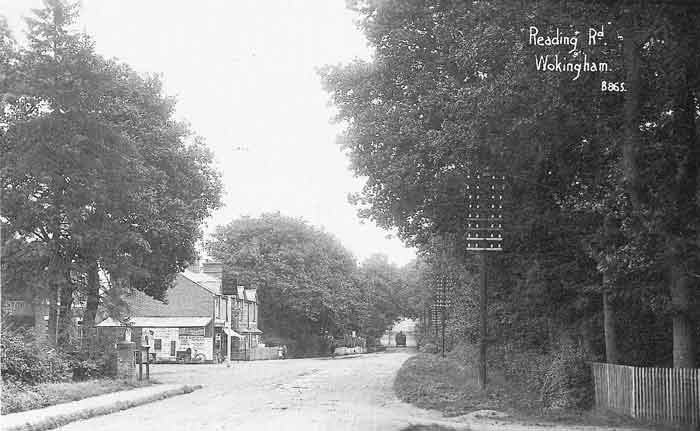
1901 to 2011
Today, although it retains the name it has been extensively refurbished, and there is a minor industrial estate behind the public house.
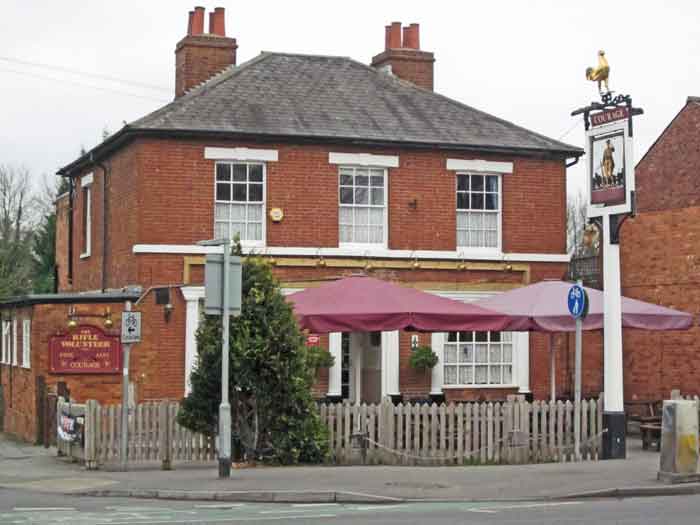
The Rising Sun – 18 Oxford Road
1901 to 2011
(We have no earlier photos of this establishment.)
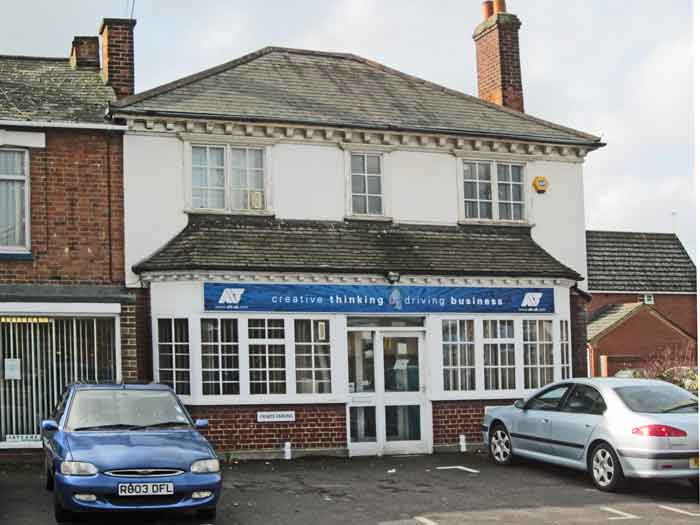
The Roebuck – 8 Market Place
Up to 1901
The Roebuck is a 16th century house that was enlarged and modified in the 16th and 20th centuries. A part of the building next to the coach entrance has been used as a shop since early in the 20th century; prior to that time the frontage of the inn was almost double its present width.
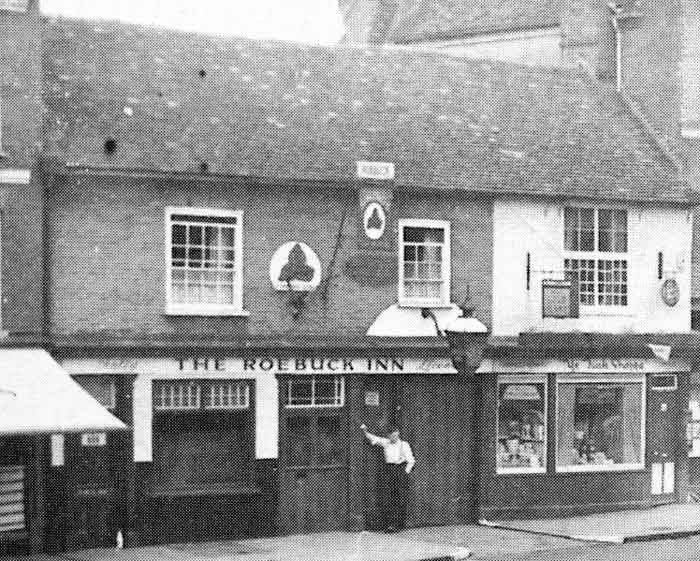
1901 to 2011
The Roebuck has now been turned into a bar and grill, the 'Square One'. The coach entrance is still visible.
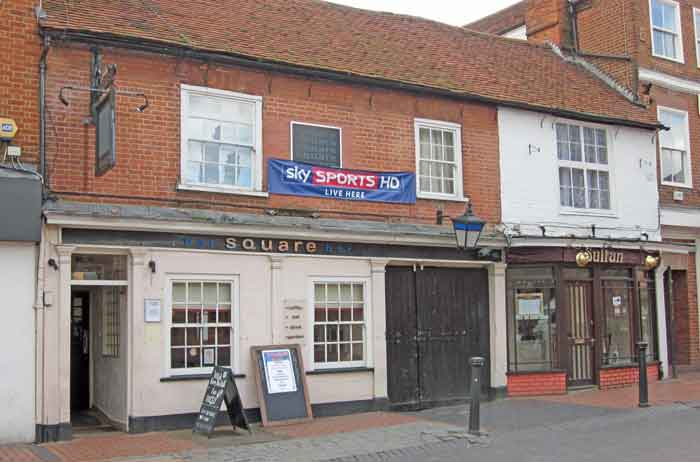
The Rose Hotel – 30 Market Place
Up to 1901
The original Rose Inn stood on the north side of Market Place. It ceased being used as an inn in 1844, at which time the current owner moved to the other side of Market Place, to its present position. This was because John Wise wanted to provide 'better accommodation and comfort for the nobility, gentry and public'. The Rose Hotel (as it has been since 1920) was once two buildings, but was then extended to provide extensive stabling, a lock-up coach house and a large garden at the rear. It has been one of the centres of Wokingham life ever since.
[The New Rose was an inn in Peach Street, which lasted only a dozen years, around 1770-1780)].
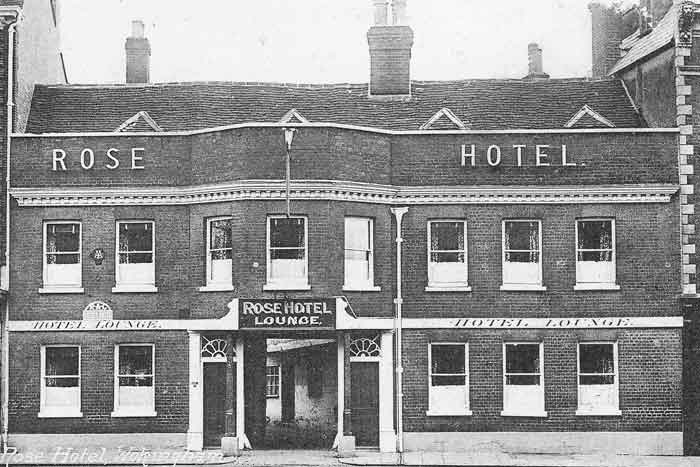
And this is a photograph of the hotel from the back.
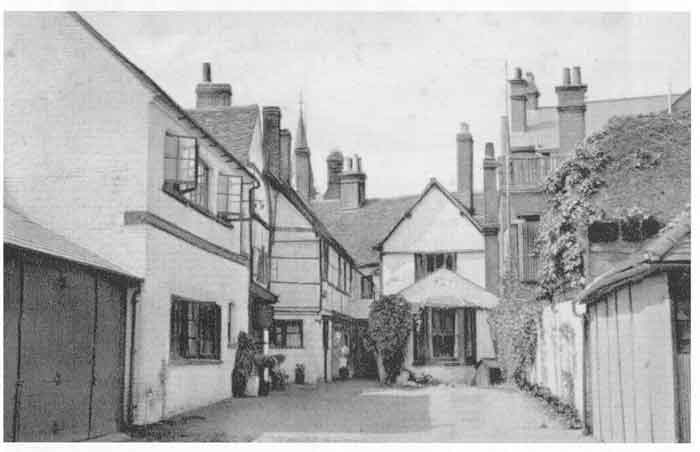
1901 to 2011
The name 'The New Rose' lasted until 2010 when, despite the sign remaining over one of the disused entrances, it effectively became a bar/grill called the Café Rouge.
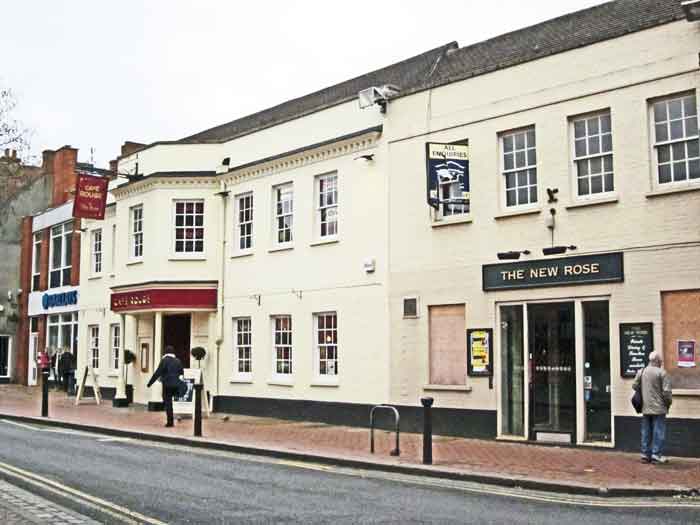
The Royal Exchange – 20 Denmark Street
Up to 1901
The Royal Exchange can be seen on the right. The advertisement shows that it was owned by Simmonds Brewery at the time.
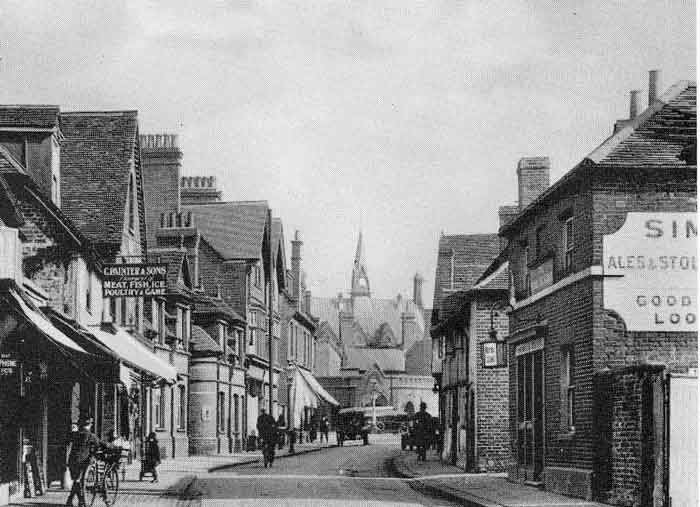
1901 to 2011
The location is now a shop and office space.
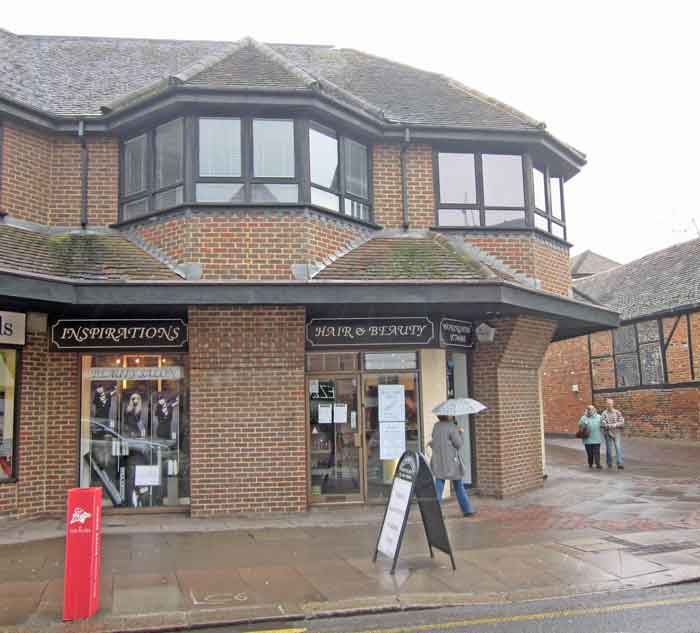
The Royal Oak – 3 Milton Road
Up to 1901
The Royal Oak was round the corner from the old Police Station. It closed in the mid-20's and was demolished some years later.
1901 to 2011
The location is now a grass area and turning circle.
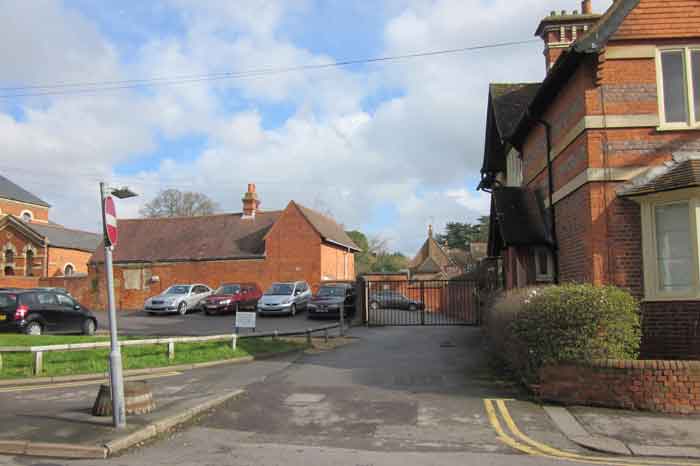
The Shades – 15 Broad Street
Up to 1901
The Shades was a beer house, opened in 1851 after some local opposition from other breweries and the well-to-do residents of Broad Street, in the front of Bakers/The Wokingham Brewery in Broad Street. Rosalind Baker, a member of the brewing family, lived at the Shades.
1901 to 2011
The Shades is now an estate agent.
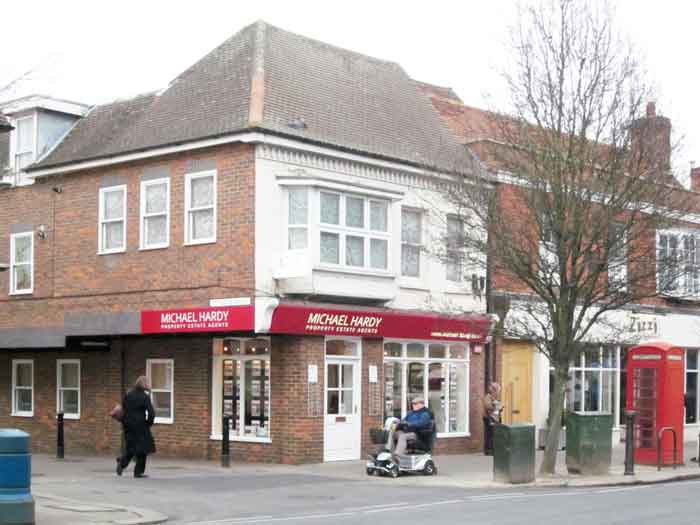
The Ship – 104 Peach Street
Up to 1901
The oldest part of the present Ship is the 17th century timber framed building at the corner of Peach Street and Wiltshire Road. It has been much altered; the original outer walls having been replaced with brick while many of the internal walls have been removed.
1901 to 2011
Today, some of the original beams can still be seen in the bar, together with a number of replicas, steel girders covered with wood, where walls have been removed. The western part of the building was a blacksmith’s shop while part of the building and part of the car park occupy the site of three of the l5th century Westende almshouses.

The Star – 56 Peach Street
Up to 1901
The Star Inn was directly opposite what is now known as Easthampstead Road, but what was until 1886 known as Star Lane (hence the Star Lane railway crossing).
1901 to 2011
The inn closed in 1909 and has since been demolished and its site taken over by this parade of 'modern' shops.

The Thatched Cottage - Emmbrook
Up to 1901
The original public house was a thatched cottage, which was probably built in the early 19th century. It was bought by Simonds, the Reading Brewer, in 1866 and rebuilt just before 1901.
1901 to 2011
The Thatched Cottage still exists as a pub, but now officially under the name of the 'Emmbrook Inn', although Googling the old name still turns up many results and Barnett's street map still uses the previous name.
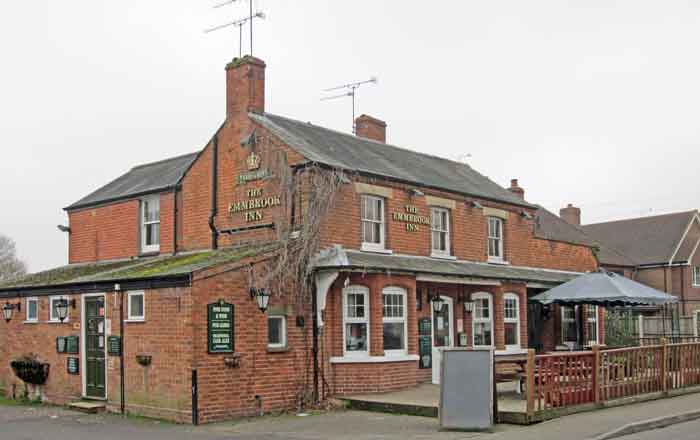
The Three Brewers – 3 Barkham Road
Up to 1901
The building started as an alehouse in the 1850s and by 1869 was owned by the Simmonds Brewery.
1901 to 2011
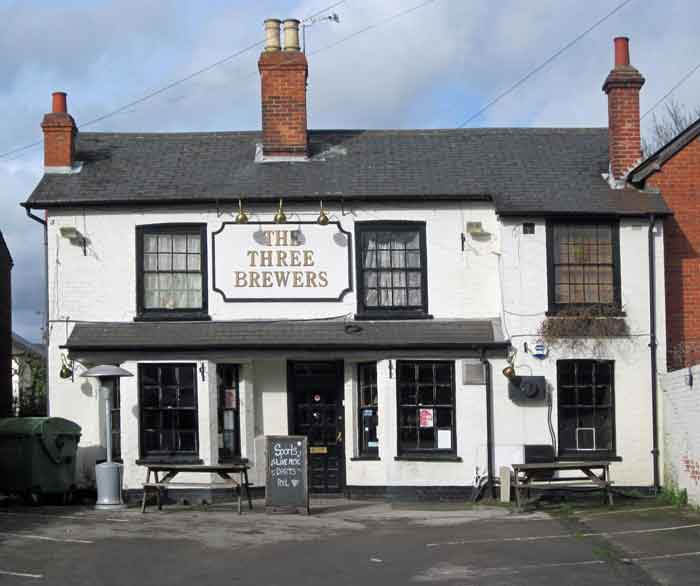
The Three Frogs – 222 London Road
Up to 1901
Although this public house was once a private house known by the name of Frog Hall, it has been so much altered, particularly in recent years, that it is hard to see any thing of the original building. Although it has been called the Three Frogs for over two hundred years, no one has yet been able to conclusively find out the origin of this name. The most plausible suggestion is that the name was derived from Frog Hall. In turn the hall was thought to have been named after the animals themselves, which abounded in the area because of its former boggy nature
By 1823 it was owned by Haywards Brewery.
1901 to 2011
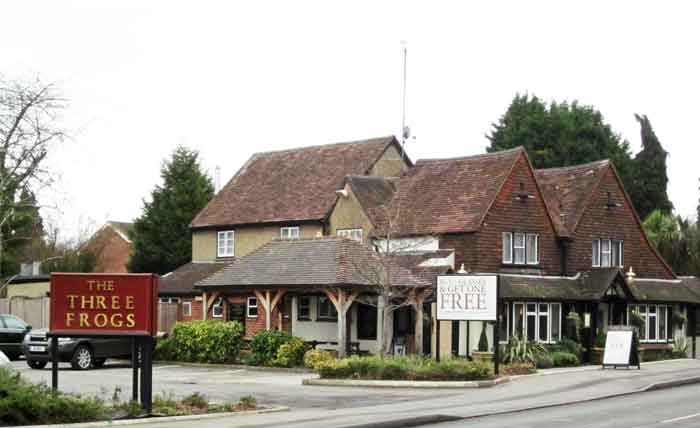
The Two Poplars – 118 Finchampstead Road
Up to 1901
The building is on the site of an earlier building and then was rebuilt or at least extensively altered in the 1850s, probably at the time it was first used as a beer house. Recent additions dwarf the older structure.
The Two Poplars was originally a beer house catering for the workers building the railway from Guildford to Reading. The beer house was at first called the Engineer, and then the Engineer’s Arms, or lngineers’ Arms. Sometime before 1880 the name had changed to the Two Poplars.
It was leased to various breweries before being sold to Henry Hewlett of the Waltham St. Lawrence brewery in 1888.
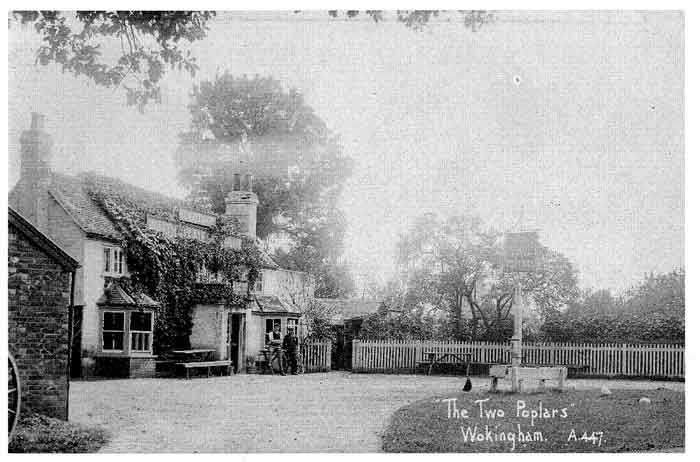
1901 to 2010
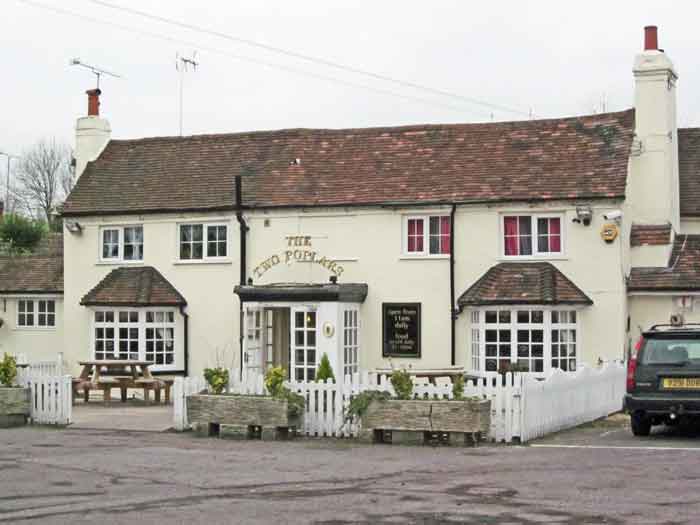
The Victoria Arms – 1 Easthampstead Road
Up to 1901
The original house was one of a pair of late 18th century brick tenements in Easthampstead Road, then known as Star Lane. In 1847 the beer house was bought by Hewetts Brewery.
In l85l Henry Baldwin bought the adjacent property and expanded his main business, building coaches, not merely their wheels. The business flourished, but in 1861 it was sold to George Lush. George Lush did so well that within a few years he was supplying coaches to the Royal Family. The pub and the coach-building firm were run by the same family until 1907. The last licensee and coachbuilder was Frank Lush.
1901 to 2011

The Warren House – Forest Road
Up to 1901
The name is derived from Warren House, the name of the farm that stood on the site as early as 1681. In turn the farm probably took its name from a medieval rabbit warren, which is thought to have existed in this part of Wokingham; owning a warren was then a privilege.
The first known reference to the building as a public house is in an advertisement in the Reading Mercury of 15th November 1777, which announced a pigeon shoot "at the Warren House, Mr Calloway’s".
The name appears to have varied more than that of any other public house in the Wokingham district. After the change to the New Warren House in 1817, it changed back to simply Warren House before 1820, only to become the Warren Inn by 1824. In the 1830s and early 1840s it was known as the Warren House, only to become the New Warren House by the 1850s, which name remained in use until recently. Today it is once again the Warren Inn, although there is no evidence that the traditional functions of inn-keeping were ever carried out there!
1901 to 2011
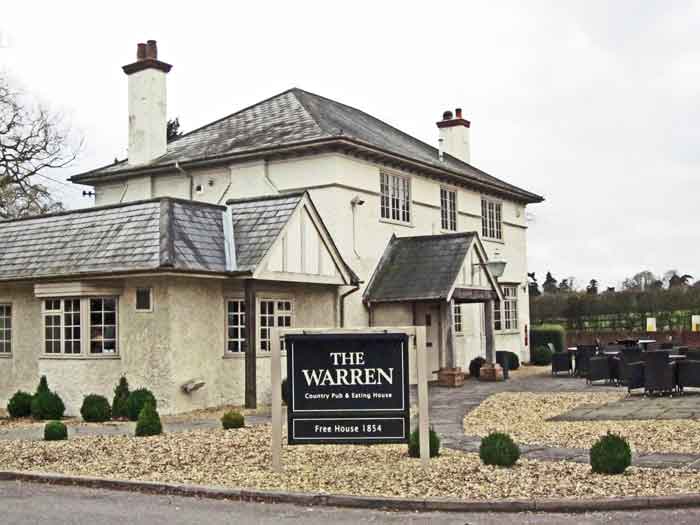
The Welcome Inn – 33 Peach Street
Up to 1901
The Welcome Inn started trading in 1850.
1901 to 2011
This parade of shops, including the ex-Woolworths store, was redeveloped in the 1930s. By the early 1960s the pub had closed and is now a hairdressers.

The Wellington Arms – 23 Denmark Street
Up to 1901
In 1856, when the Haywards empire was being split up, Robert Trickey Dunnings bought The Chair in Denmark Street. The Chair later became the Duke of Wellington, the Wellington Stores and finally the Wellington Arms. He also bought land behind the Chair upon which he built the Wellington Brewery.
1901 to 2011
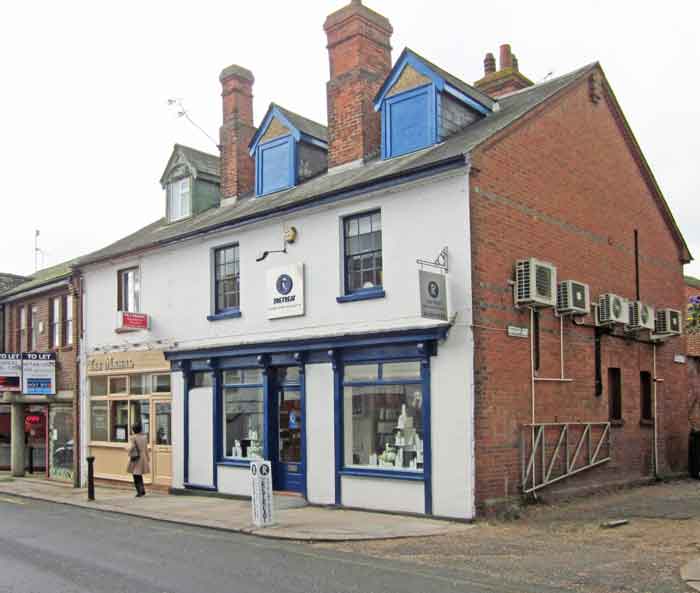
The Wheatsheaf – 14 & 15 Market Place
Up to 1901
This is a view from Market Place looking down Denmark Street. The Wheatsheaf Inn is an early 19th century building. As can be seen it was not tied to a brewery, selling both Allsopps Ales and Stollery Brothers wines and spirits.
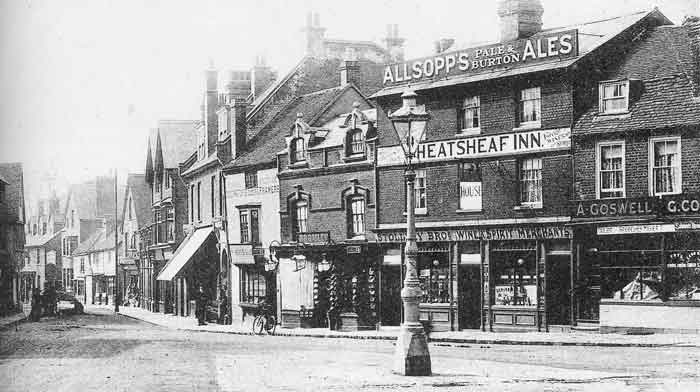
1901 to 2011
The building is now occupied by a branch of Fat Face.
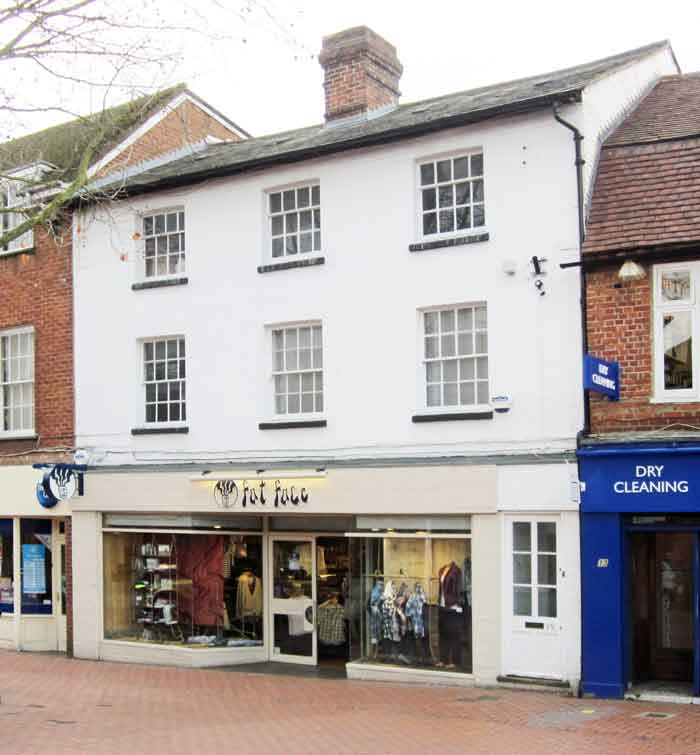
The White Hart – 65 Rose Street
Up to 1901
In 1901 this was one of 7 public houses in the short length of Rose Street. It was the home of the Rose family.
1901 to 2011
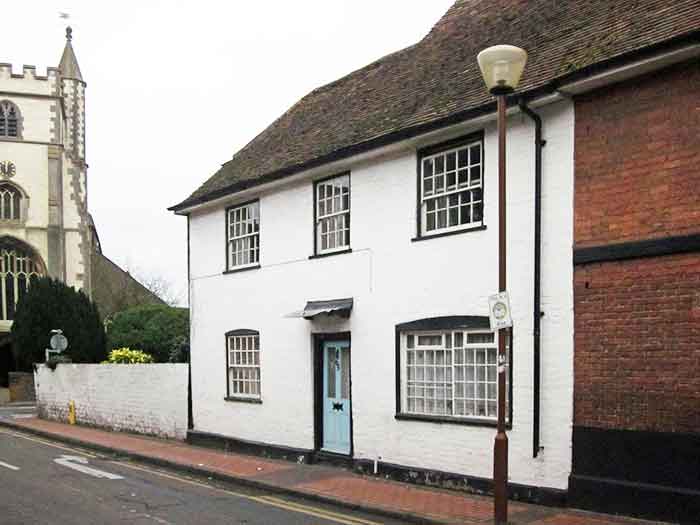
The White Horse – Easthampstead Road
Up to 1901
In 1882 Hewett’s Brewery built the current building, which fronted directly onto the Easthampstead Road.
1901 to 2011
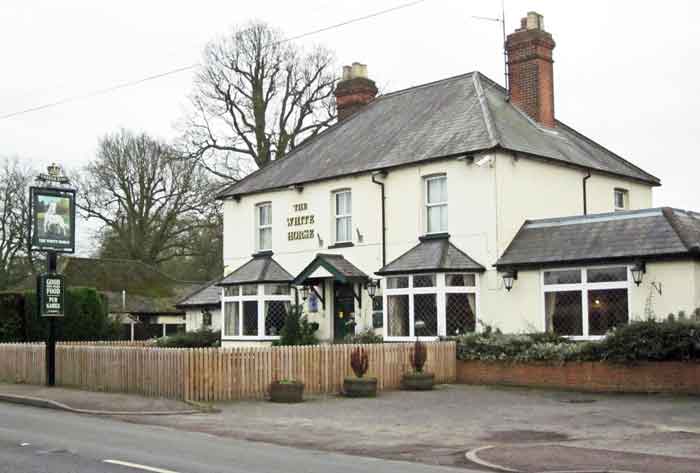
An earlier original alehouse is the small brick built house, now 'White Horse Cottage', just to the right (north) of the 'new' public house.
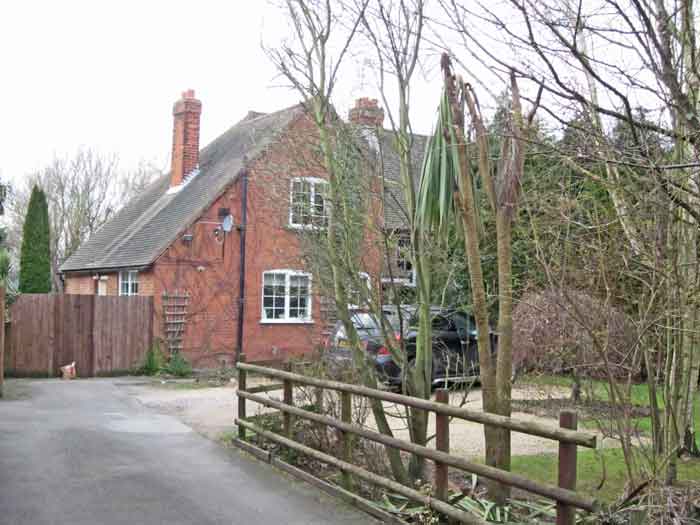
The Who'd a Thought It – Nine Mile Ride
Up to 1901
The unusual name, first recorded in 1861, is said to have originated in a remark by the Duke of Wellington. The story goes that travelling in the forest one day and feeling very thirsty he suddenly came across the pub. His exclamation ’Who’d a thought it' became the name of the pub. It is an unlikely story since the there are several other pubs by the same name in other parts of the country and the pub wasn't open when Windsor Forest existed.
According to the historian Bryant Lily-White, the name is thought to have been taken from the suggestion of a wag that the motto to the coat of arms of a certain baronet-brewer should be:
Who'd a thought it?
Hops had bought it.
1901 to 2011
The pub was closed and demolished in 2003. The area has been redeveloped as a small residential estate. The latest Barnett's street map of Wokingham still includes a public house in this area, showing its former position.
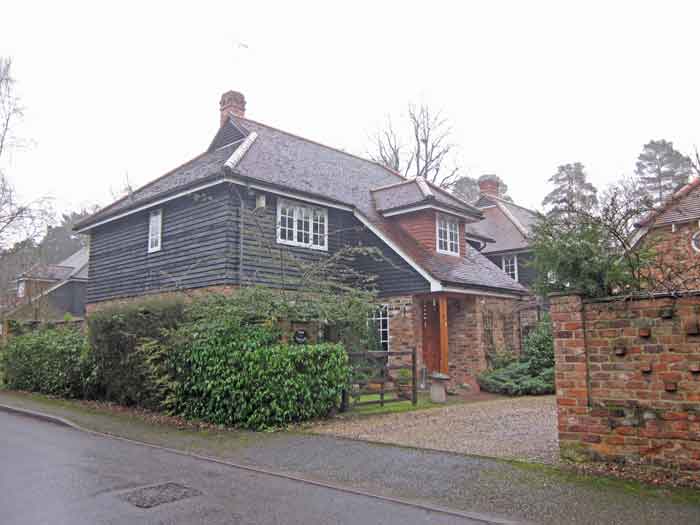
The Wine Vaults – Market Place
Up to 1901
As its name implies, the Wine Vault started life as a wine and spirits merchants. It remained as such for some long time, until being taken over briefly by the Wellington Brewery and then being sold on to Daniel Heron, who switched it to a public house.
1901 to 2010
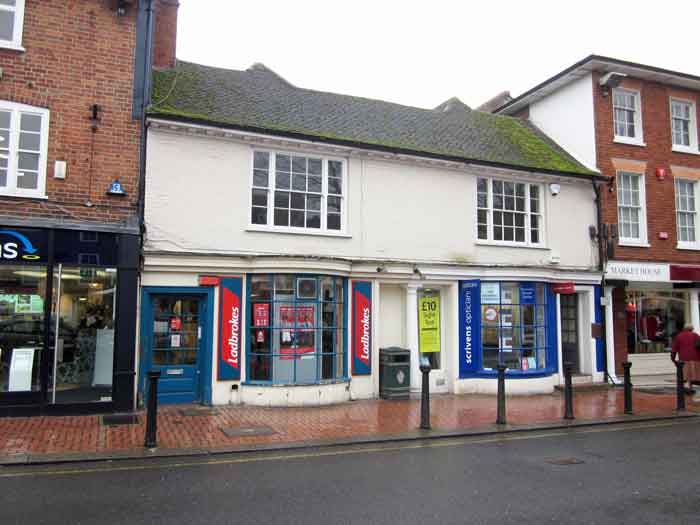
Ye Old Leathern Bottel – 221 Barkham Road
Up to 1901
The recorded history of this alehouse begins in 1737 when it was an isolated roadside alehouse in the middle of an area of desolate heath. It was then merely known as the Leathern Bottle. (See also the New Leathern Bottle). Since then there have been many changes of the name; the Bottle, the Old Bottle and the Old Leathern Bottle.
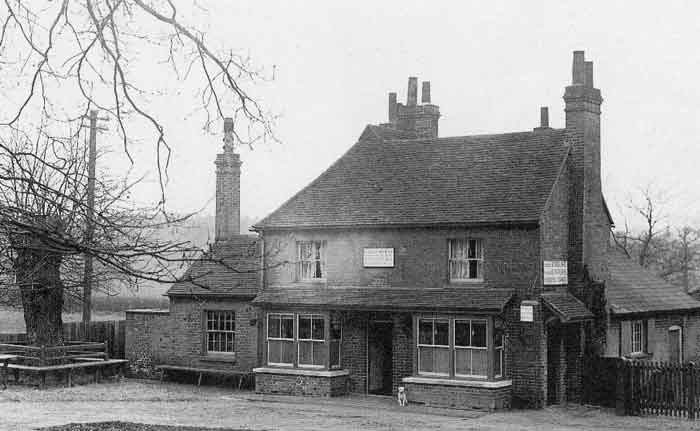
1901 to 2011
Yet another variant of the name is now preferred – it's currently a 'Bottel'.
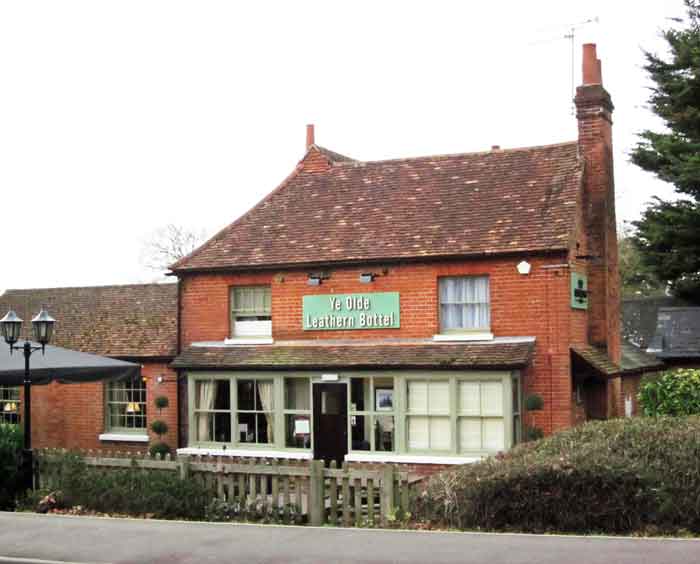
Breweries
Haywards Brewery – Reading Road
Up to 1901
Up until 1856 there was only one significant brewery in Wokingham, that of William Hayward (who had bought the original business from James Webb).
James Webb bought Beches Manor on Reading Road in 1760 and started the brewery on that site. In 1762 he bought the Leathern Bottle for £300 and began the tradition of 'tied houses'.
The brewery by 1856 owned 40% of all the alehouses and public houses.
When it was put up for auction, no other breweries in Wokingham were sufficiently large to put in offers for many of its licensed premises, most going to breweries outside Wokingham – such as Brakspears (Henley) and Hewetts (White Waltham).
1901 to 2011
The site is now occupied by the Wokingham Youth Centre – itself undergoing some renovations.
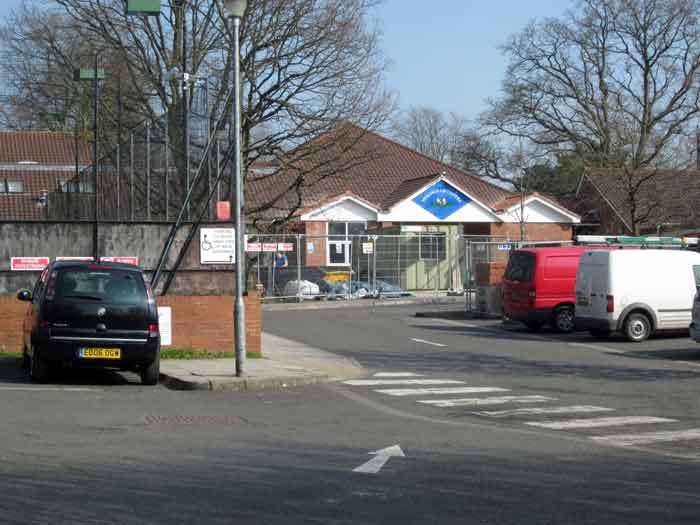
Bakers/The Wokingham Brewery - Broad Street
Up to 1901
Residential sites and industry are seen here side by side, at 15 Broad Street. The Wokingham Brewery is behind No. 15, one of the properties that front onto Broad Street.
Originally Baker's Brewery, it became known as The Wokingham Brewery late in the 19th century. By this time it had acquired at least four public houses, the Crooked Billet, the Crown, The Hope and Anchor and the Railway Hotel.
In 1857 it opened The Shades, a public house, at the front.
In 1901 Rosalind Baker was the owner.
It was sold to Brakspears in 1914, but they only wanted its tied properties and the brewery itself closed down early in the 1914-18 war.
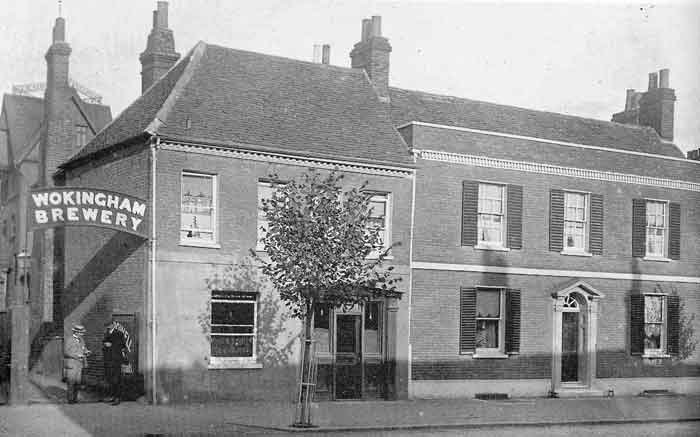
1901 to 2011
Although the building on the corner (what was The Shades alehouse) is still recognisable, down the passage way there are now new office developments where the brewery itself was located.
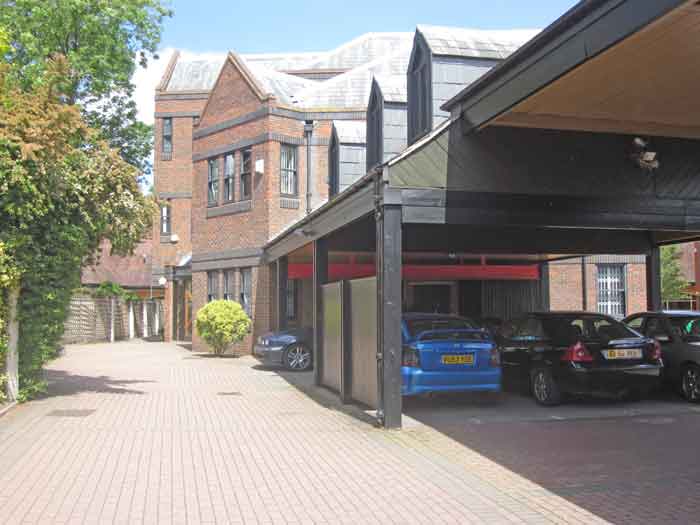
The Wellington/Headington Brewery – Denmark Street
Up to 1901
In 1856, when the Haywards empire was being split up, Robert Trickey Dunnings bought The Chair in Denmark Street. He also bought land behind the Chair, upon which be built the Wellington Brewery. The estate was taken over first by Frank Headington and his cousin Richard Webster, in partnership, and then by Frank's son John, who was the owner in 1901.
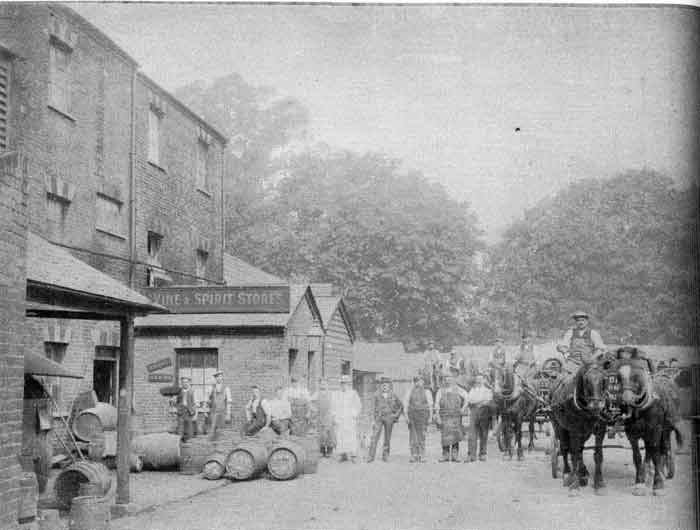
1901 to 2011
The brewery flourished until 1920, when it was sold to Ashbys of Staines. As usual in these cases, the new owners wanted the tied pubs as outlets for their own beer, rather than the brewery for its beer.
The site of the brewery is behind 'The Plaza'.
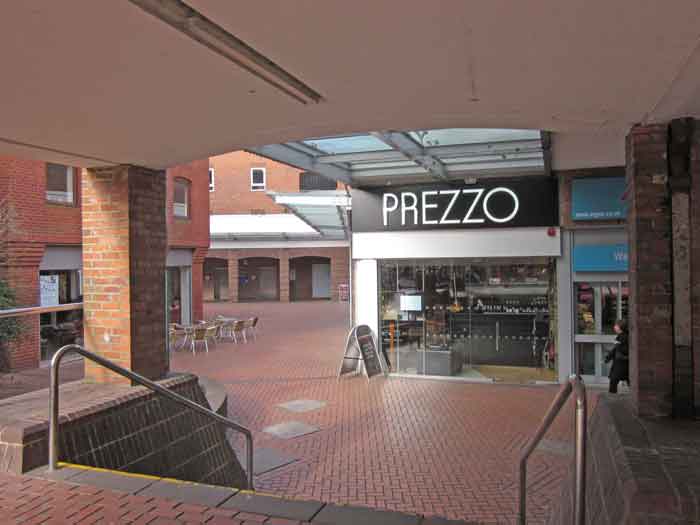
Eagle Brewery – 7 Peach Street
Up to 1901
The small Eagle Brewery at 7 Peach Street opened about 1820. The 1830 Beer Act allowed it to retail its own beer, so it obtained an off-license. In 1854 the brewery was bought by Hewett's Brewery of Waltham St. Lawrence but appears to have closed by 1863, although it continued as a beer and spirits retailer until 1982.
1901 to 2011
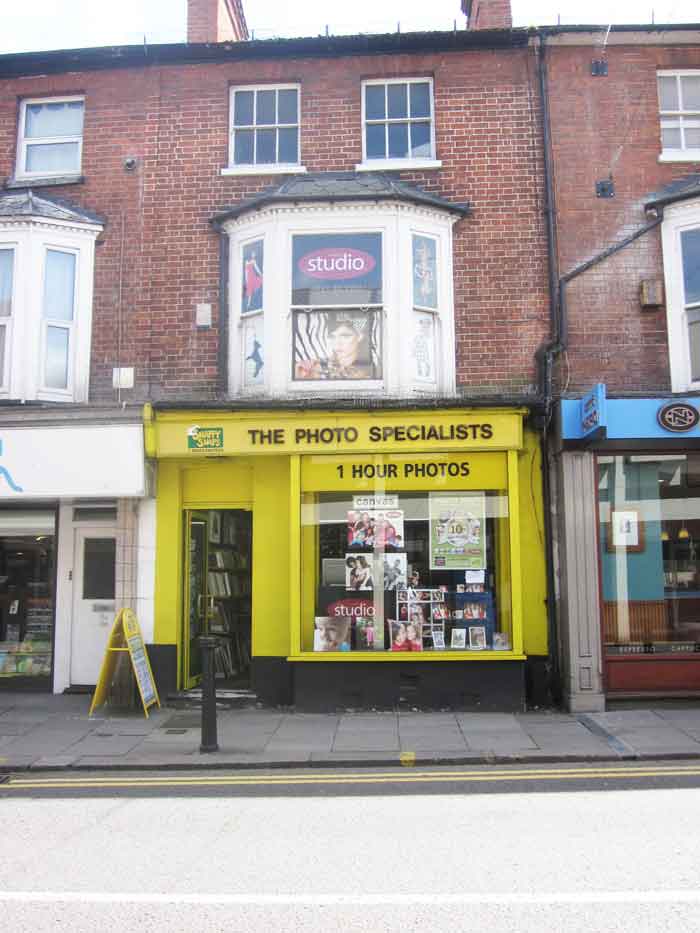
Bibliography
Here is a list of the source material used while compiling these pages.